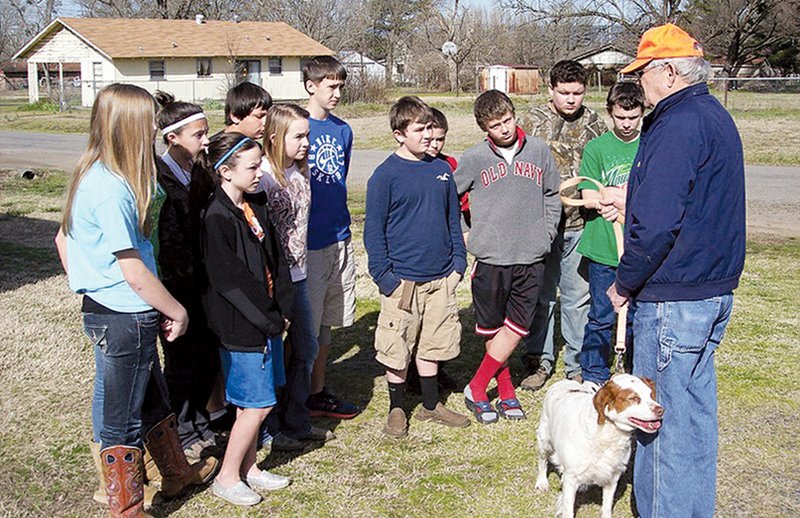OLA — Most people have heard of Save the Whales, but some Two Rivers School District students want to Save the Quail.
Jim Yeager, instructional technology specialist for the district, said bobwhite-quail hunting used to be big in Yell County.
“Lots of communities had bird hunting in their culture — a Saturday-morning hunt and lunch of quail and biscuits and gravy,” Yeager said.
Yeager, who lives in Russellville and works part time for the district, said he was discussing quail hunting one day with gifted-and-talented-education teacher Marlene Bishop.
“She introduced it to her GT kids and realized no one had ever seen [a quail],” he said. “That’s amazing in a community where the culture was so bird-hunting oriented.”
The quail just aren’t there, he said, “and it’s a shame.”
“They’re very, very rare. It’s really — whichever old timer you talk to — you can get a different picture of what happened to them.”
The GT students wanted to know. They started researching the topic about 1 1/2 years ago, and Environmental and Spatial Technology students jumped on board, Yeager said. He is the technology consultant for EAST, and Kip Grimes is the teacher.
EAST students will sponsor a community meeting at 7 p.m. Feb. 6 in the high school auditorium to discuss the disappearance of the bobwhite quail. The high school, at 17727 E. Arkansas 28, is between Ola and Plainview.
Clifton Jackson, quail/small-game program coordinator for the Arkansas Game and Fish Commission, will discuss the decline and possible quail-restoration strategies, Yeager said.
Ryan Fitch, 18, a senior at Two Rivers High School, was involved in the beginning of the quail research.
“When I was younger, my family and I used to quail hunt a lot,” he said.
Fitch said his family even grew large portions of hay for the quail to hide in, “and we used to have small, fast dogs to hunt them a long time ago.”
It’s been a long time since he has seen a quail, Fitch said.
Fitch said he thinks it’s because of the increase in bobcats and coyotes.
Yeager said an additional theory is that hawks, which are protected, are plentiful and prey on the quail.
“They are after the little fellows as soon as they can walk,” he said.
Phillip Young, executive director of the Arch Ford Education Service Cooperative in Plumerville, used to be an avid quail hunter.
A former superintendent of the Ola School District, which consolidated with Plainview to form Two Rivers, Young said he moved to Plainview when he was a teenager.
It wasn’t until his 20s that he got interested in quail hunting.
“This time frame was the early ’70s, and it was very good — great fun,” Young said. “The main advantage, or plus, was you could train a dog very easily because there were a lot of quail. It didn’t take very many hunts for [the dogs] to get very experienced.”
Young said he can pinpoint when quail hunting changed.
“It really made a sharp decline in 1980, as a matter of fact,” he said.
He said a couple of weather events occurred in 1980 that he believes affected the quail population.
“We had a really wet fall, floods, which are very detrimental to quail nests,” Young said, which are located on the ground.
“Then we had the extreme hard freezes with ice,” Young said. “Then on top of that, there’s such protection of predators, hawks, and the coyote population just multiplied.
“I’m certainly not a wildlife scientist, but with the increasing population of deer and turkey, it increased the menu for predators, and of course, quail is on every predator’s menu. The young are very small, and they’re very fragile. The mortality rate for wild quail is high.”
Young said EAST students interviewed him and others with an interest in bird hunting.
“The kids interviewed some of us and utilized their technology skills in terms of doing the interviews,” he said.
“I think it’s a great example of student-centered project learning, and that’s really the direction we’re trying to move students and teachers and school districts,” Young said. “It’s heightening their interest, which will increase reading and writing, which is always the goal.”
Also, students will use math skills in the quail project.
“There will be a lot of opportunity for them to look at statistics and manipulate numbers,” Young said. “Yeager … deserves a lot of commendation for his leadership on this.”
Fitch, who said he has moved on to another EAST project, said, “I’m hoping they’ll get a few people interested in putting in money and build some habitats for the bobwhites, or a breeding facility.”
Fitch also said the students want to hear from anyone with information about quail management or building habitats.
“The end goal is to see if it’s hopeless,” Yeager said. “The end goal is going to determine if there’s anything these kids can do because community service is such a big part of what EAST does. Kids like solutions. … They almost immediately went from research to solutions; they got a lot more interested in solutions.
“I just don’t know if it’s hopeless.”
Senior writer Tammy Keith can be reached at (501) 327-0370 or tkeith@arkansasonline.com.
